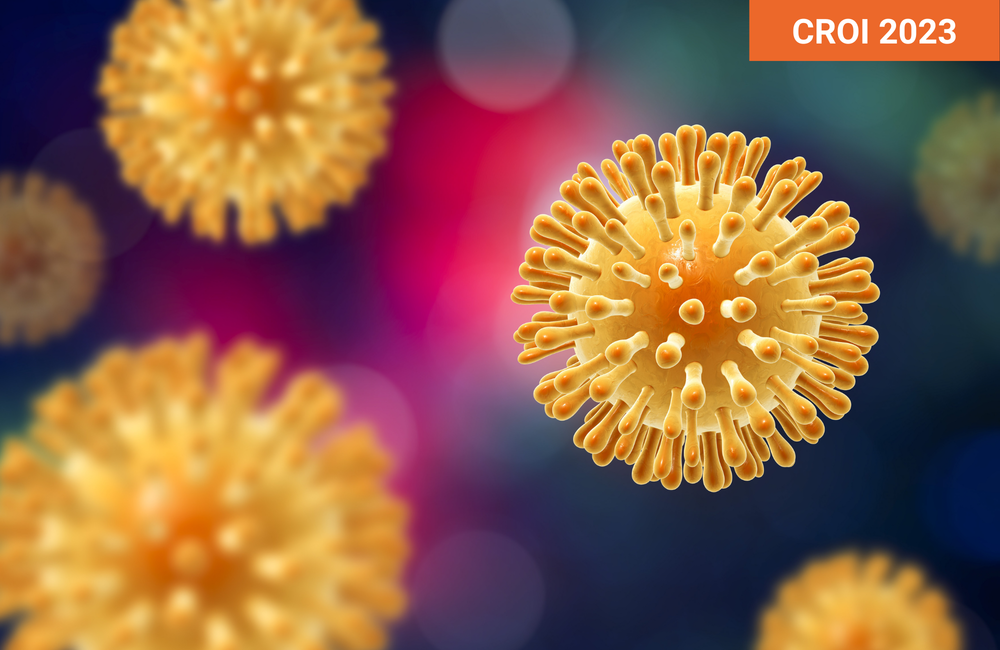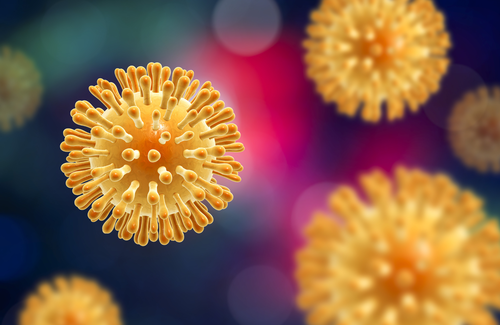
A poster and a talk both presented at the recent Conference on Retroviruses and Opportunistic Infections (CROI 2023) dampened down expectations that a cure for HIV may soon be possible using less risky and expensive methods than the stem-cell transplants that have so far cured five people (see this report for the latest).
Dr Natalie McMyn of Johns Hopkins University has found that, although during the first few years on antiretroviral therapy (ART) the number of cells capable of producing viable HIV (if ART is stopped) shrinks, in people taking ART continuously for a longer time, the size of this reservoir of virally-productive cells declines no more and may even slowly start to increase. The amount of cells with any HIV DNA in them, whether productive or not, also stops declining after ten or so years on ART and may increase.
McMyn’s study is co-authored by several leaders in HIV cure research, including Professors Steven Deeks, Robert Siliciano and Janet Siciliano.
Its implications were explored in a talk given by Dr Jared Stern of Seattle’s Fred Hutch Cancer Institute at the Community Cure Workshop held the day before CROI opened.
Stern said that strategies aiming to cure HIV either by targeting cells for immune destruction (the ‘shock and kill’ strategy) or by forcing them into permanent quiescence (the ‘block and lock’ strategy) may not be sufficient in themselves to achieve a cure for HIV. A delicate, sequential balance of different strategies may be necessary.
Background
The reason for the eventual stabilisation and even growth of the reservoir is that in the early years on ART, many cells remain that are capable of actively producing HIV viral particles. This is why the average viral load in people on ART is, at least initially, in the region of 2-4 copies per millilitre instead of zero.
When these cells do produce viable HIV, while they can infect new cells, they also become visible to the immune system. This both targets them for immune destruction, and sets them on the pathway towards apoptosis – programmed cell death.
Later on however, cell division, rather than viral replication, becomes more important. Even the long-lived T-memory cells that form most of the viral reservoir have to divide now and then in order to replenish the body’s T-cells, often in response to infection. Because of this, later on, active viral production becomes rarer and the reservoir is mainly replenished by cell division.
When infected cells divide, they do not have to express HIV proteins or otherwise start the process of making virus – they simply split, duplicating their DNA, including their HIV proviral DNA, as they do. These cells contain identical ‘clones’ of HIV, because DNA has much less chance to mutate during cell division. This is called clonal expansion.
The study
McMyn’s study involved 31 people who had been on fully-suppressive ART for a median time of nearly 23 years. All have maintained viral undetectability. Starting with CD4 counts of near-zero (this was the late 1990s), their median CD4 count rose to about 800 15 years after starting ART, but after that declined a little and plateaued at around 650.
The researchers took purified resting CD4 T-cells from each participant’s blood and did two tests. Firstly, they did a viral outgrowth assay. This measures the proportion of cells that can be induced to produce viral particles in the lab dish.
Previous investigations by Robert Siliciano in the early 2000s found a slow decrease in productive cells. He calculated that the HIV reservoir had a half-life of 44 months on ART, meaning the number of virally productive cells would halve in just over two years. This would mean that two per million resting CD4 cells being able to produce viable virus at baseline, that number would have gone down tenfold in 12 years and a hundredfold in 24.
This was not what they observed: the proportion of cells that were productively infected went down for the first 3-4 years on ART but then stopped decreasing and may even have increased very slightly since then.
The other test was a DNA assay of the cells, to detect all cells that contained lengths of proviral DNA. Because most of these are fragmentary or mutated and so can’t produce virus, about 100 times as many CD4 T-cells contain proviral DNA than can produce viable virus. If the trend indicated by earlier studies continued, we’d expect the proportion of cells containing HIV DNA to decline from 200 per million to two per million in 24 years too.
But the proviral DNA reservoir only declined in about the first nine years on ART and even then by not very much. After that it stayed steady or grew slightly and is now back to where it started in most of the participants studied. The proportion of DNA-containing cells that could produce viable virus was the same regardless of the amount of time on ART. The amount of DNA-containing cells and productively-infected cells differed by two orders of magnitude between the 31 individuals, but were correlated within individuals.
By successively diluting cell samples, the researchers genetically sequenced every DNA sequence in the CD4 resting T-cells they sampled in three individuals. From two of these people, viable virus could be produced from some samples, but not from the third person’s cells. In this individual, virtually all viral isolates (DNA sequences) were genetically distinct from each other. Only three out of 44 sequences formed a pair with one of the other ones, indicating cloned DNA.
In the other two people, 19% of 59, and 36% of 97 proviral DNA sequences gave rise to fully replicating virus. In the first case, every single sequence that produced viable virus was identical, clearly originating from one single cell that had divided. There were three other clonal sequences that did not produce virus.
In the second case, 18 out of the 35 sequences that produced virus were identical, and three others almost identical. The other 14 productive sequences were, however, all different from each other apart from one pair, and there were 11 other clonal sequences that did not produce virus. These were mainly pairs and triads of identical sequences, but there was one clone of seven cells with identical DNA that was not productive.
Implications
Natalie McMyn’s main conclusion from her findings was that, while in some cases the HIV reservoir may stop being capable of producing new virus, in the large majority, cellular proliferation keeps the reservoir of cells containing viable virus topped up – so we should not expect there to be too many people who can stop ART without their viral load bouncing back.
Jared Stern drew wider conclusions from this and related studies.
They said that as time goes by, the reservoir changes its nature under ART. Because active cells are cleared or self-destruct more quickly than inactive ones, over time the reservoir becomes less productive and more latent.
“ART is good at preventing cells from becoming infected,” they said. “But it’s no good at stopping them staying infectious.”
‘More latent’ means less likely to activate, but also less visible to the immune system – which creates a dilemma for cure researchers. Should they attempt to activate more cells and alert the immune system, risking the danger of enlarging the reservoir with a new wave of cellular infections – or should they try to maintain latency, even though in some people that means maintaining cells that will contain persistently viable viral DNA?
Essentially, people with HIV face a lottery during acute HIV infection. The virus' position of integration into a cell's nucleus is rather random but it tends to pick sites nearest to the exterior of the nucleus, and these tend to be the areas where commonly active genes are being expressed. If HIV finds itself in a length of DNA that is rarely or never expressed – the so-called ‘gene deserts’ – then even if the cell divides, it is unlikely ever to start producing virus.
On the other hand, if it is integrated into a gene that is often active, then it will likely be expressed when the gene activates. ART stops HIV’s enzymes from getting very far into the process of producing viral components – but it does not stop the cell dividing and cloning those potentially productive sequences.
This implies that before we can devise a safer and cheaper cure for HIV than wholesale replacement of the immune system, we need to answer some outstanding research questions we don’t know the answer to:
What determines whether a cell becomes productive (and so dies) or latent (and therefore survives)? What determines that a cell switches from being latent to being productive? Why do some T-memory cells divide clonally and not others? Does HIV itself have a part to play in clonal expansion?
Should a cure make HIV less, or more, latent? Is long-term ART sufficient, at least in some proportion of people, to produce a deeply latent reservoir that can’t rebound when ART is stopped? And how do we know who those people are?
McMyn NF et al. Persistence of inducible replication-competent HIV-1 after long-term ART. 30th Conference on Retroviruses and Opportunistic Infections, Seattle, abstract 396, 2023.
Update: Following the conference presentation, this study was published in a peer-reviewed journal:
McMyn NF et al. The latent reservoir of inducible, infectious HIV-1 does not decrease despite decades of antiretroviral therapy. The Journal of Clinical Investigation, 133: e171554, September 2023.
DOI: 10.1172/JCI171554
Stern J. Effects of long term ART on the HIV reservoir. Treatment Action Group 2023 Pre-CROI Community HIV Cure Research Workshop, Seattle.

